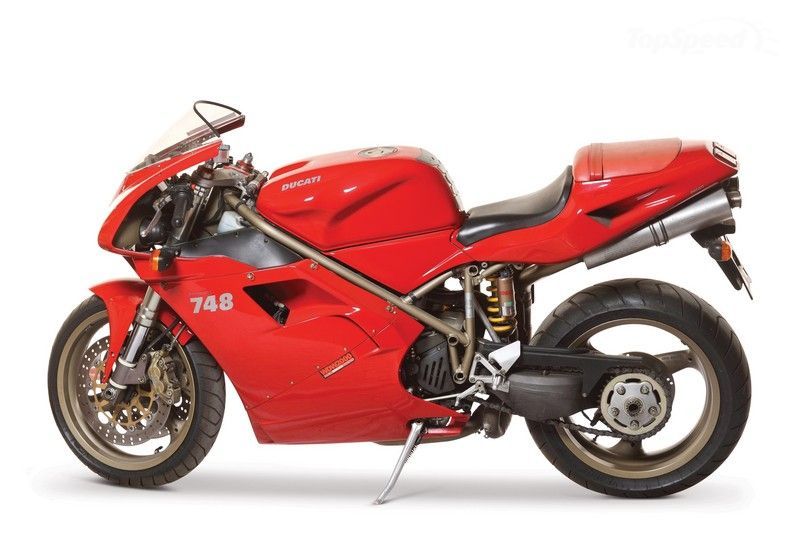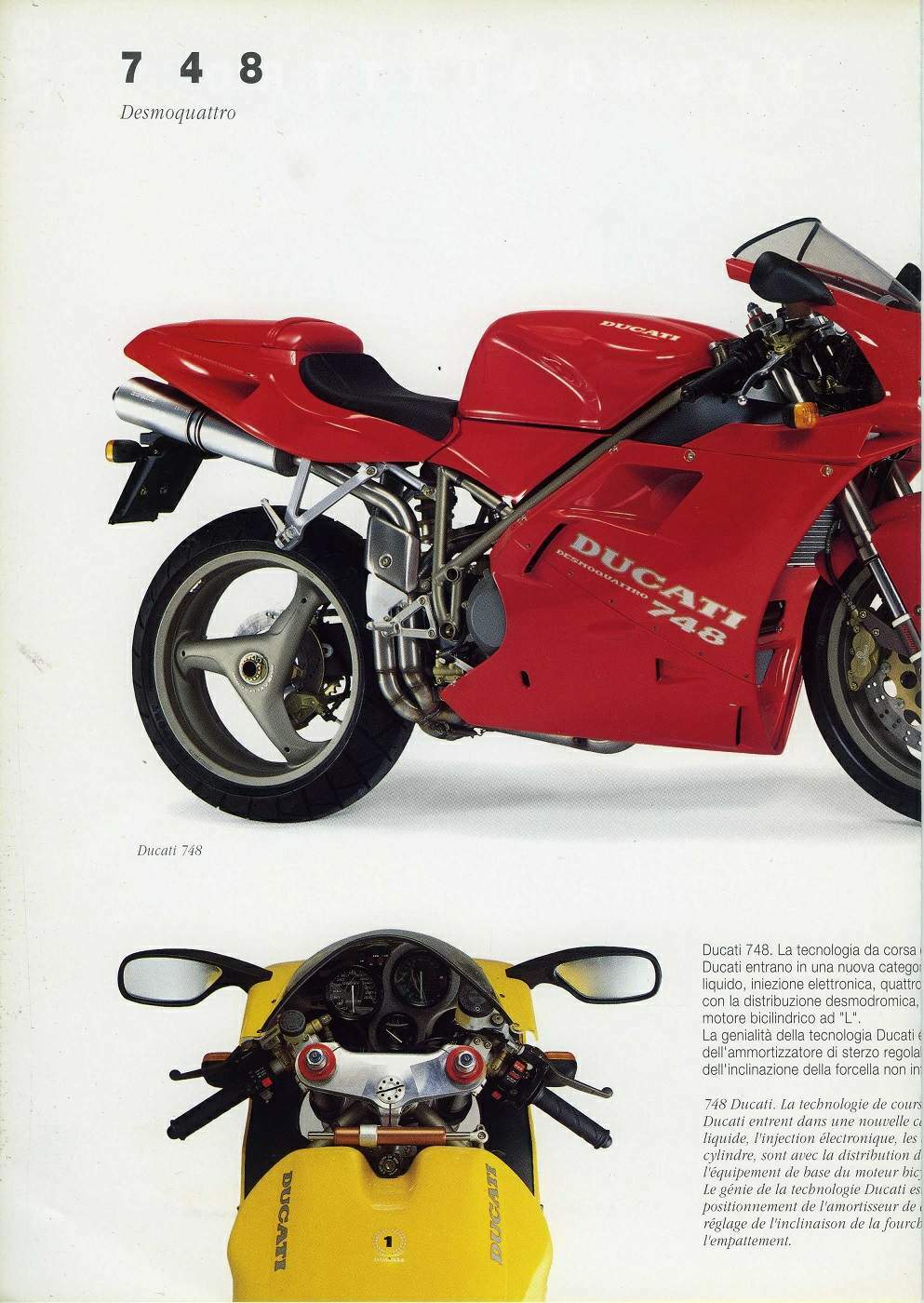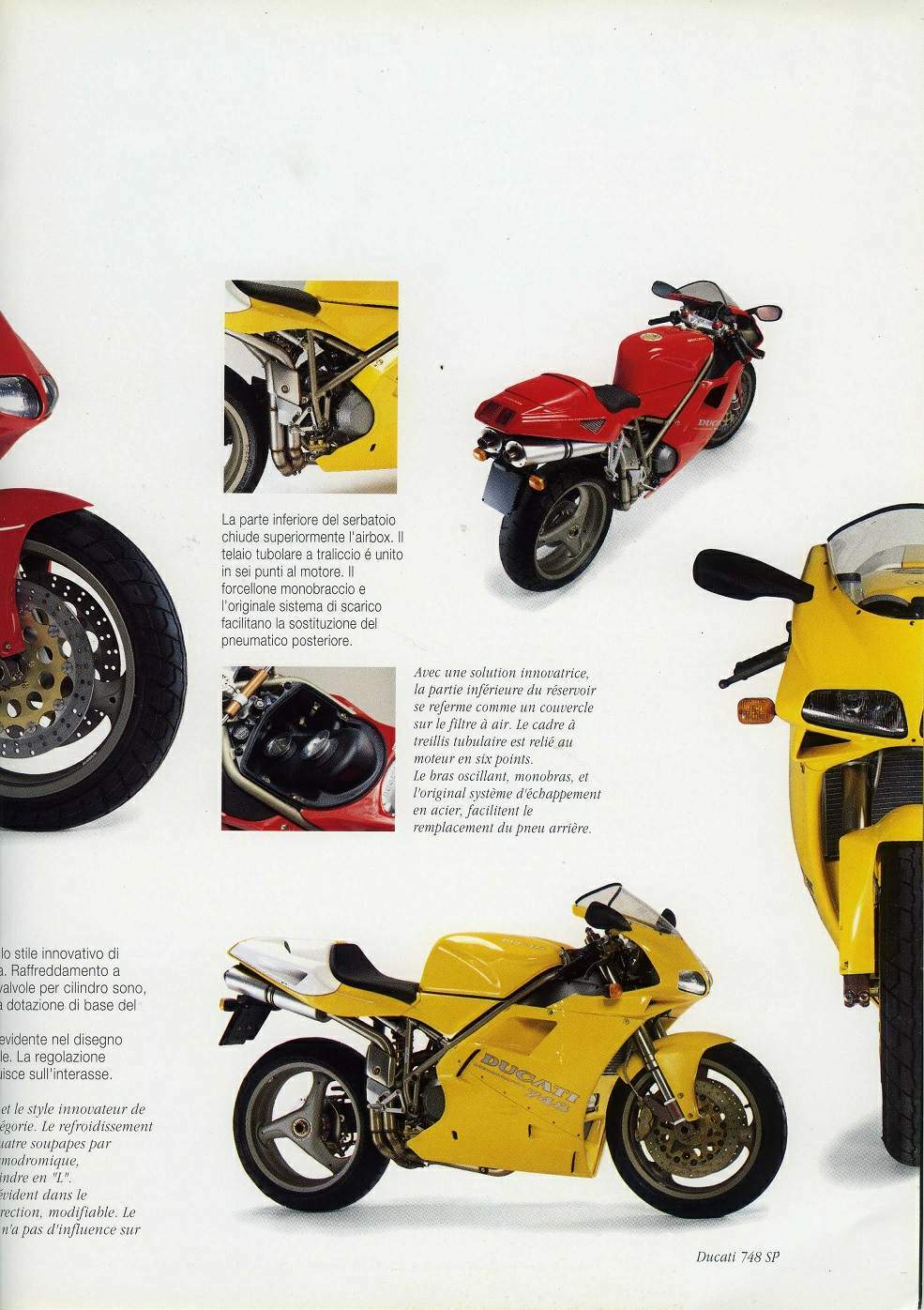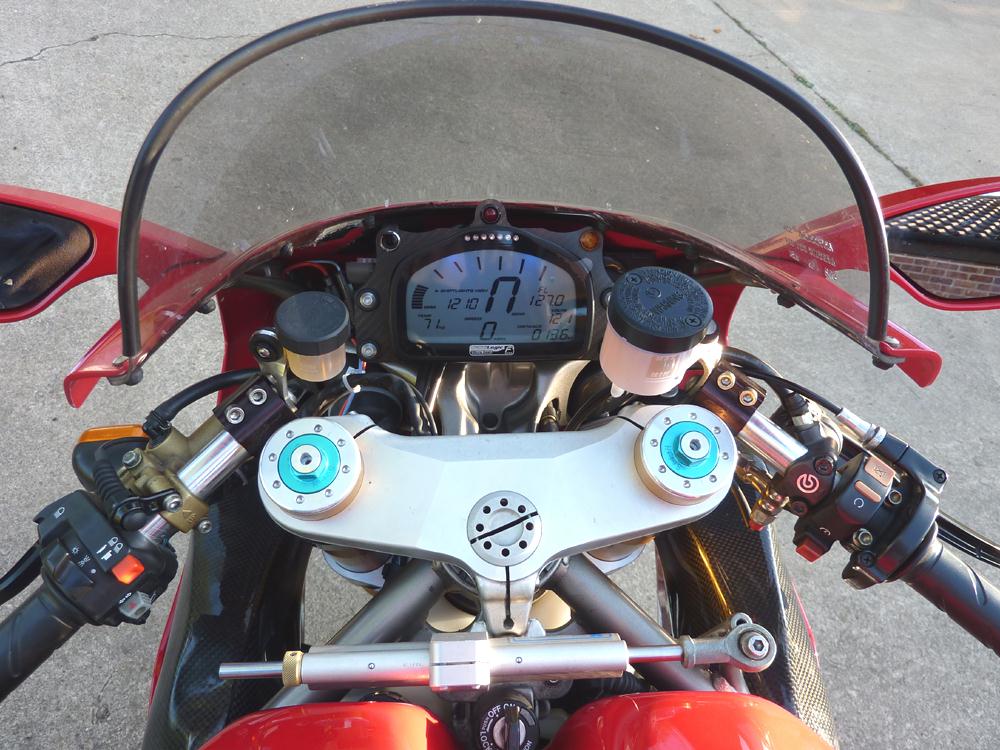
|
|
|
|
|
|
Classic Bikes
Custom Bikes
Individual
Racing Bikes AJP
AJS
Aprilia
Ariel
Avinton / Wakan
Bajaj
Benelli
Beta
Bimota
BMW
Brough Superior
BRP Cam-Am
BSA
Buell / EBR
Bultaco
Cagiva
Campagna
CCM
CF Moto
Combat Motors
Derbi
Deus
Ducati
Excelsior
GASGAS
Ghezzi Brian
Gilera
GIMA
Harley Davidson
Hero
Highland
Honda
Horex
Husaberg
Husqvarna
Hyosung
Indian
Jawa
Kawasaki
KTM
KYMCO
Laverda
Lazareth
Magni
Maico
Mash
Matchless
Mondial
Moto Guzzi
Moto Morini
MV Agusta
MZ / MuZ
NCR
Norton
NSU
Paton
Peugeot
Piaggio
Revival Cycles
Roland Sands
Royal Enfield
Sachs
Sherco
Sunbeam
Suzuki
SWM
SYM
Triumph
TVS
Ural
Velocette
Vespa
Victory
Vincent
VOR
Voxan
Vyrus
Walt Siegl
Walz
Wrenchmonkees
Wunderlich
XTR / Radical
Yamaha
Zero
Video
Technical
Complete Manufacturer List
|
Ducati 748
|
|
Make Model |
Ducati 748 Biposto |
|
Year |
1995 - 96 |
|
Engine |
Four stroke, 90°“L”twin cylinder, DOHC, desmodromic 4 valves per cylinder, belt driven |
|
Capacity |
748 cc / 45.6 cu in |
| Bore x Stroke | 88 x 61.5 mm |
| Cooling System | Liquid cooled |
| Compression Ratio | 11.5:1 |
| Lubrication | Wet sump |
| Engine Oil | Semi-Synthetic, 10W/40 |
| Oil Capacity | 3.5 L / 3.7 US qt / 3.1 Imp qt |
|
Induction |
Weber I.A.W. CPU 1.6M |
| Spark Plug | Champion RA 59GC |
|
Ignition |
Electronic |
| Battery | 12V 16Ah |
| Starting | Electric |
|
Max Power |
72.1 kW / 98 hp @ 1100 rpm |
|
Max Power Rear Tyre |
66.8 kW / 90.8 hp @ 10900 rpm |
|
Max Torque |
75 Nm / 7.65 kg-m /55.3 ft-lb @ 8700 rpm |
| Clutch | Dry, multi-plate, hydraulic control |
|
Transmission |
6 Speed |
| Primary Drive Ratio | 2:1 (31/62) |
| Gear Ratios | 1st 2.466 / 2nd 1.765 / 3rd 1.400 / 4th 1.182 / 5th 1.043 / 6th 0.958:1 |
| Final Drive Ratio | 2.71:1 (14/38) |
| Final Drive | Chain, 520 VL4 - 5/8" x 1/4" |
| Frame | Trestle type constructed of "ALS 450" steel alloy |
|
Front Suspension |
Inverted type, 43 mm diameter stanchions, Showa GD051, fully adjustable |
| Front Wheel Travel | 127 mm / 5.0 in |
|
Rear Suspension |
Progressive linkage with adjustable monoshock, Showa GD052-007-02 |
| Rear Wheel Travel | 130 mm / 5.1 in |
|
Front Brakes |
2 x 320mm Discs, 4 piston calipers |
|
Rear Brakes |
Single 220 mm disc, 1 piston caliper |
|
Front Tyre |
120/60 ZR17 |
|
Rear Tyre |
180/55 ZR17 |
| Rake | 25° |
| Dimensions |
Length: 2050 mm / 80.7 in Width: 685 mm / 27.0 in Height: 1090 mm / 42.9 in |
| Wheelbase | 1410 mm / 55.5 in |
| Seat Height | 790 mm / 31.1 in |
| Ground Clearance | 150 mm / 5.9 in. |
| Handlebar Height | 850 mm / 33.5 in. |
|
Dry Weight |
202 kg / 441 lbs |
|
Fuel Capacity |
17 Litres / 4.5 US gal / 3.7 Imp gal |
|
Consumption Average |
5.8 L/100 km / 17.3 km/l / 40.7 US mpg / 48.9 Imp mpg |
|
Braking 60 km/h - 0 |
13.3 m / 43.6 ft |
|
Braking 100 km/h - 0 |
37.7 m / 123.7 ft |
|
Standing ¼ Mile |
11.2 sec / 195.2 km/h / 121.3 mph |
|
Top Speed |
248.7 km/h / 154.3 mph |
First launched in 1994, the 748 was a smaller-capacity version of the 916 introduced the year before.The 748 was similar in many ways - the frame, suspension and brakes were largely identical to the larger bike. The maximum power output was not much less either, at 73kW (98bhp) compared to 81kW (109bhp) for the original 916. Perhaps surprisingly, the 748 felt markedly different on the road. The more highly tuned 748cc engine had to be revved higher for the same power output, and this rewy nature tended to make the rider feel more involved in the riding experience. Minor chassis differences - mostly different tyre sizes - give a different feel on the road, and many consider the 748 to be the better steering machine.
Source Bike Magazine of 1999
All that is best from the old country doesn't compare to the work of art that is the Ducati 748 Biposto (meaning two seater).
People look at you very differently when you ride a 748. You could be a film star (Trainspotting's Ewan McGregor has one) or a pop star or just someone with more money than sense, but the secret is, you haven't spent more than the cost of a modern Japanese bike.
The 748 we had last year covered 8500 miles without a problem. No electrical grief. No desmodromic histrionics. No bother at all.
We're not saying that it's into the 'kick the tyres and fire it up' league of Japanese bikes, but maybe Ducati's reliability gremlin isn't as active as it used to be. Certainly we had no problems with our 748 last year, and the experiences of other owners seems to back this up.
Riding the 748 shows that it is harder work than any other four cylinder machine, but that also means it's much more rewarding to get it right. The riding position of holding the front wheel spindle in your hands, while offering your bum up to the sun god means that your wrists, back, arse and knees endure varying degrees of pain (depending on your size).
Suffice to say it's no fun around town - what with all that pain and slightly snatchy motor at low revs - but that's not what it's built for.
And remember, these things aren't really for two, even if you've bought the Biposto. But if you go out and find some sweeping A-roads, you'll be hard pressed to find anything finer, especially for £8000-£8500. Many rate the 748 as the better buy over the 916/996, purely because the engine is a little rewier, therefore making the transition to the beautiful world of V-twins that much easier.
If you can choose the colour, remember that everyone loves red 916s, but if you can get hold of a yellow 748, you will feel extra special.
A set of pipes and you'll have the beautiful, unstifled sound to go with those looks. Careful when buying pipes, though, as any choice other than the very Italian Termignoni will see Don Giovanni and his rock hard nephews turning up on your doorstep. You have been warned.

Review
To the joy of American riders, Ducati has finally decided to import the 748. Considered a baby brother to the 916, Ducati's 748 has been the darling of the European motorcycling press since its introduction. Basically a smaller-displacement version of the 916, the 748 trades off torque and low-end grunt for a higher rev limit through tricks like a lightened flywheel.
The 748 made a surprise debut at the International Bike Show this year - Ducati showed up with one screaming-yellow single-seater, a price tag, and that's it. No brochures, no specs, but promises to deliver 200 copies to the States starting at the end of January. Only the solo seat version would be coming here, they said.
But remember, we're dealing with an Italian motorcycle company. The bikes did arrive on time, amazingly enough, but other features like owner's manuals, shop manuals, warranty cards and so forth are apparently arriving "under separate cover." Interestingly my local dealer, Salem Honda/BMW/Ducati, opened the crate to find not a solo version, but a Biposto. Today's story from Bologna is that 40 of the promised 200 748s will be Bipostos.
Both versions are solid "I can't believe it's not butter" yellow, but the Biposto forgoes the single-seater's white pseudo-number plate tail section, instead having a vinyl passenger seat dyed yellow to match the rest of the tail, which it does surprisingly well. The wheels, like the frame, are a bronze/gold color. Not only do they look great in combination with the yellow paint, but more importantly, they hide brake dust and road grime well. If you've ever owned a bike with white wheels, you'll know what we mean.

Although this bike is gorgeous, a careful
inspection reminds you that it's definitely not a Honda or a Suzuki. A close
look at the painted bodywork reveals a substantial amount of orange peel -- but
nothing you'd notice unless your eyes were six inches away, waxing it under
bright lights late at night in your garage (sigh). The neutral light indicates
you might be somewhere near neutral, so you have to carefully feed out the
clutch if you think you're there. And just because the neutral light isn't on,
you can't assume you're in gear.
Gearbox action is pretty good (neutral demons aside), shifting easily but
without the precision click feedback of a GSX-R. The shift lever is adjustable,
of course, as are nearly all the controls on the bike, and shifting improved
once I lengthened the connecting rod to tip the lever down more. Gearing is low
compared to, say, a GSX-R, which is a good thing. First and second gears are not
only usable around-town gears, but the shift down from second to first is very
crisp, better than any other bike I've ridden, with the exception of a Honda
RS125 race bike.
Although hydraulic, clutch effort requires the Jaws of Life. Also, brake feel is
on the spongy side, but switching to braided steel lines made a phenomenal
difference. The rear brake is pretty much ornamental. There's no fear of locking
it up, even if you did something as unholy as ride this bike in the rain. It
merely serves to settle the suspension slightly, and to keep the bike from
rolling backWards from a stoplight on a slight hill.

Surprisingly, Ducati has the Japanese manufacturers
beat in a couple of design tricks. For instance, the positive terminal of the
battery is easily accessible through the right body panel air vent, so you can
hook up a trickle charger for storage season without removing any bodywork. And
when you do remove the bodywork, it all comes off with Dzus fasteners.
Additionally, Ducati has chosen to make the vast majority of other fasteners one
of three sizes of allen wrench, or two sizes of ordinary nut, so you spend very
little time scrounging in your toolbox for even fairly major servicing.
Gas mileage is pretty good, producing about 100 miles in around-town driving
before the low fuel light comes on, indicating one gallon left of 4.5 gallons.
Weight of Ducati's 748 is just over 400 pounds, but feels much lighter.
On the road, you feel like Snoopy doing his vulture
impression, perched seemingly out over the front wheel. Strangely, this doesn't
put your helmet out in the open wind, and turbulence is minimal. The reach to
the bars is fairly extreme -- remarkably similar in feel to the Honda RS125R
two-stroke GP bike -- feeling very narrow with extremely direct and sensitive
steering. Unfortunately, it also puts a lot of weight on your wrists. Because of
this, the passenger seat is for briefly impressing your friends. If your
significant other isn't tiny, you're going to have to get rid of either them or
the bike. The riding position throws much of the passenger's weight on your
upper back, which of course ends up on your wrists, tempting you to do a big
wheelie and throw them off the back.

Throttle response is instantaneous, and thankfully devoid of the turbine-like
windup experienced on a Japanese inline four. Under 5,000 rpm, it feels like an
underpowered four-stroke single, making lots of thumping noises, but not really
getting anywhere. Above 6,000 or so, it snaps alive and streaks away more like
you'd expect, keeping your left foot busy on the shift lever. There's very
little perception of speed or acceleration compared to a Japanese inline four.
On the Ducati, you either realize you're screaming along by the rate at which
other traffic appears to be parked, or by glancing down at the speedo.
The little Duck is an absolute blast to ride. Hell, it's a blast just to sit on at stoplights, ripping the throttle open, pretending to be checking some adjustment in the engine. I want to ride it through the store when I get my groceries. I want to widen my front door, and build a ramp so I can park it in my living room (hey, it doesn't leak oil). Get rid of that new car you bought, buy an old beater for those rainy days, and spend that car payment on one of these demons instead.
Source
Motorcycle.com
|
Any corrections or more information on these motorcycles will be kindly appreciated. |